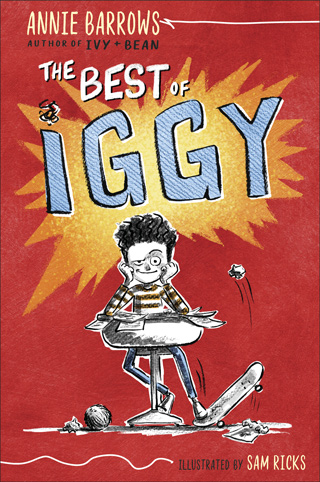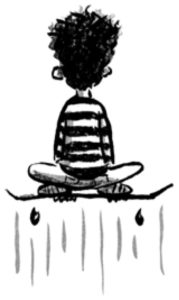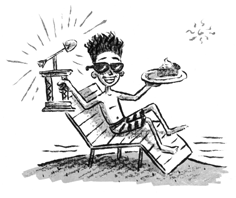 People Are Talking About Iggy
People Are Talking About Iggy
2025 Elementary Nutmeg Award Nominee (Connecticut)
2025 Grand Canyon Reader Award Nominee (Arizona)
2021-22 Virginia Readers’ Choice Award Nominee
2022-23 Maud Hart Lovelace Award/Minnesota Youth Reading Award Nominee
2022-23 Louisiana Readers Choice Award Nominee
2021-22 Texas Bluebonnet Nominee
2021-22 Pennsylvania Young Readers Choice Nominee
2021 ALSC Notable Children’s Recording
“This book is deeply ethical and totally hilarious. It’s wise, generous, and delightfully unsanctimonious. Seriously: The Best of Iggy is one of the finest and funniest middle-grade books I’ve read in years.”
–Mac Barnett, author of the bestselling Terrible Two series
“If you’ve ever done anything you regretted, or never regretted anything you’ve done, IGGY is for you.”
–Jon Scieszka, inaugural National Ambassador for Young People’s Literature
“You’d have to have a heart of stone not to love Iggy. It’s not his fault he’s always in trouble. Well, it’s mostly his fault, but there are Very Compelling Extenuating Circumstances. Wise, sensible, smart children everywhere will hurl themselves (safely) at this hilarious new series from Annie Barrows.”
–Sophie Blackall, Caldecott Medal Winner and illustrator of the Ivy + Bean series
“Warning: Do not let ‘extenuating circumstances’ keep you from getting to know the inimitable Iggy. You’ll be laughing so hard—pancake everywhere—that you won’t even realize the young troublemaker just stole your heart.”
–Megan McDonald, author of the Judy Moody and STINK series
“Only Annie Barrows could have penned this outrageously clever, laugh-out-loud book, a magical feat that somehow combines hilarious hijinks with a thoughtful look at why we make mistakes — and how we make amends. I haven’t adored a well-intentioned troublemaker this much since Henry Huggins and Junie B. Guaranteed fun, this is the perfect family read.”
–Katherine Applegate, Newbery Medal Winner for The One and Only Ivan”

The New York Times Book Review
Written by Annie Barrows (of “Ivy and Bean” fame) and illustrated by Sam Ricks, The Best of Iggy (Putnam, 144 ppp, $13.99; ages 8-12) is not what most people might imagine as a graphic novel. It is more of a heavily illustrated middle-grade tale. But its lively mix of text and both large and small black-and-white illustrations in a reader-friendly design of plenty of white space is a welcome variation in middle-grade storytelling.
Twenty fast-paced short chapters tell the story of a mischievous fourth grader named Iggy Frangi, who gets in trouble for three incidents. Barrows’s deadpan omniscient narrative voice is brilliant. Explaining that Iggy is the hero of the book only because he is the one who does things in it. Warning that all the things Iggy does (in this book) are bad. Helpfully listing the “Three Types of Things We Wish We Hadn’t Done.” And even more helpfully defining “extenuating circumstances.”
Fellow fourth graders will love Iggy for his honesty and humor. But everyone will probably love him most for his motto: “It Seemed Like a Good Idea at the Time.”
Booklist, starred review
The Best of Iggy
By Annie Barrows. Illus. by Sam Ricks
Jan. 2020. 144p. Putnam, $13.99 (9781984813305). Gr. 2–5
Meet Iggy, a mostly good fourth-grader who frequently gets in trouble. As the story opens, he’s confined to his bedroom because his parents have (from his point of view) misunderstood the extenuating circumstances that led him to threaten another boy and follow him up the ladder to the shed roof, from which the other boy, “screaming, ‘Hellllllp,’” leapt onto the trampoline below. The book’s narrator, who has nearly as large and colorful a presence here as Iggy, frames the story around people’s regrets for their actions. Using three examples involving Iggy, she differentiates between the things he wishes he hadn’t just gotten caught doing, things he wishes he hadn’t done quite so much, and things he really, really wishes he hadn’t done at all. Desk racing, which falls into the latter category, ended with Iggy injuring his favorite teacher, crying, and feeling bad whenever he remembered the incident. Writing with a droll sense of humor, Barrows ensures that kids will enjoy Iggy’s antics and perhaps even reflect a bit. Ricks’ expressive, zany, black-and-white illustrations capture chaos and amplify the fun. The first of a series, this slender chapter book is inviting to pick up, hard to put down, and near-impossible to read without laughing out loud.

Publishers Weekly
The Best of Iggy
By Annie Barrows. Illus. by Sam Ricks.
“All of us do things we wish we hadn’t done” begins this lively illustrated series opener about Iggy Frangi, a mischievous, good-hearted nine-year-old who frequently lands himself in trouble and only sometimes regrets it. The omniscient narrator describes Iggy’s world with a dry tone (“He has to stay in his room until dinnertime. It’s two thirty in the afternoon”), detailing the events—described as “extenuating circumstances”—that have contributed to Iggy’s ill-advised actions. Short chapters tell the story of three occurrences: Iggy inadvertently goading Jeremy Greerson into jumping off the roof onto a trampoline, raiding the family medicine cabinet for an overzealous prank, and racing classroom desks toward an unsuspecting fourth-grade teacher. Of the three, the last inspires regret and thoughtful introspection. With Iggy, Barrows (the Ivy and Bean series) has created a realistic kid—passionate, funny, and sometimes misguided—whom readers will surely root for as he gains awareness of the relationship between choices and consequences. Black-and-white illustrations by Ricks highlight Iggy’s antic nature. Ages 8–12.
Kirkus Reviews
Iggy Is Better Than Ever
By Annie Barrows. Illus. by Sam Ricks.
Iggy Frangi, a 9-year-old fourth grader first introduced in The Best of Iggy (2020), is not particularly adept at anticipating adverse outcomes, and his analysis after things go wrong is not especially accurate. He’s more of a doer than a dreamer. “Mostly Iggy gets in trouble. He does Thing 1, and then Thing 2 happens, and then, unfortunately, Thing 3 happens too. In a wry direct address, the narrator/apologist affirms that Iggy will not be transformed, that this is not about a kid who is “better at the end than he was in the beginning”—not “about a kid who plants flowers by the side of the road.” Thing 1: Iggy, who appears White, and two of his best friends, Diego, who has brown skin, and Arch, who appears Black, discover a creative use for gardening tape. As a result of Thing 1, Thing 2 happens: Iggy accidentally clobbers (but doesn’t permanently damage) an elderly White teacher with a basketball. Thing 2 leads to Thing 3: a spectacular, and, as it turns out, literal face-plant, “one of the best things that ever happened” in Iggy’s life. Iggy wouldn’t hesitate to do it all over again, and his fans will be the richer for it. Ricks’s sketch illustration features light-hearted diagrams and cartoon interpretations of Iggy’s thoughts and misadventures.
Very, very funny.
Kirkus, starred review
Iggy Is the Hero of Everything
By Annie Barrows. Illus. by Sam Ricks.
Iggy’s intrepid and clever selflessness is open to misinterpretation.
This installment in the chronicles of 9-year-old Iggy Frangi’s (Iggy Is Better Than Ever, 2020, etc.) encounters with unintended consequences examines intent as an element crucial to gallantry. After learning of a break-in at the Heckies’ house nearby, Iggy has a plan for thwarting the potential theft of his best Halloween candy, along with his family’s other valuables. It’s pretty simple: Set a decoy and dig a trap. It’s hardly Iggy’s fault when annoying 7-year-old Rudy Heckie is injured during the trap construction. (No, Rudy’s finger is not severed.) Nor is it Iggy’s fault that Mr. Heckie hurts his tailbone when he trips over Rudy and falls into the trap dug with the shovel that didn’t sever Rudy’s finger. The pace and energy of Barrows’ narrative matches Iggy’s focused enthusiasm for his (somewhat ill-conceived) plan. The apologist narrator, very much on Team Iggy, provides evidence that points to Iggy’s heroism. Ricks’ cartoon illustrations are a lively and hilarious complement to Iggy’s thoughts and experiences. In them, Iggy, his family, and the Heckies appear White. Iggy’s charm is substantial, so blithely optimistic are his intentions and so singular (yet familiar to any well-meaning human) his way of seeing the world. Iggy’s ideas are clear to him—it’s everyone else who ends up asking, “What were you thinking?”
This genuine and energetic, if hapless, antiheroic hero grows on you. (Fiction. 8-11)

